This article explains how to use colour in your LaTeX document via the color or xcolor packages. Note that user-level documentation of the color package is contained in The LaTeX standard graphics bundle.
Both packages provide a common set of commands for colour manipulation, but xcolor is more flexible and supports a larger number of colour models, so is the recommended approach.
We’ll start with the following example:
This example produces the following output:

In this example, the package xcolor is imported with
then the command \color sets the blue colour for the current block of text. In this case for the itemize environment.
The code to typeset the horizontal line created by \rule is contained in a group, delimited by , in order to keep the effects of the \color local to that group.
Named colours provided by the xcolor package
As noted in the xcolor package documentation, the following named colours are always available without needing to load any package options:
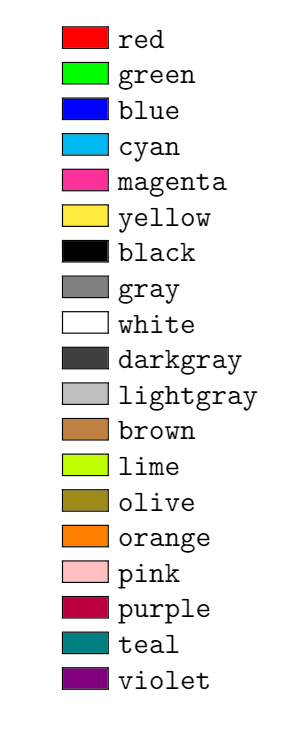
Accessing additional named colours
Additional named colours can be accessed via the following xcolor package options:
- dvipsnames : loads 68 named colours (CMYK)
- svgnames : loads 151 named colours (RGB)
- x11names : loads 317 named colours (RGB)
you can access the following named colours:
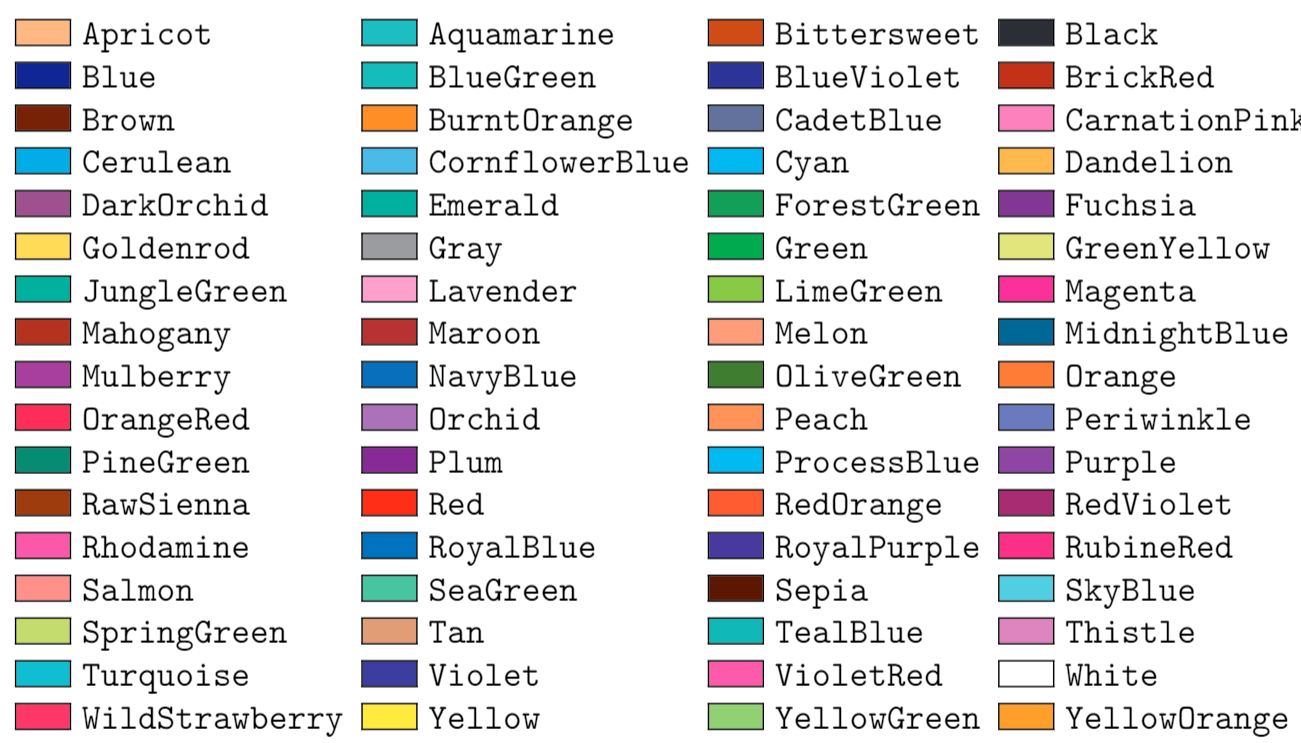
Refer to the xcolor package documentation for tabulated lists of colours provided by the svgnames and x11names options.
Example usage
The following example uses named colours loaded via the dvipsnames option.
This example produces the following output:
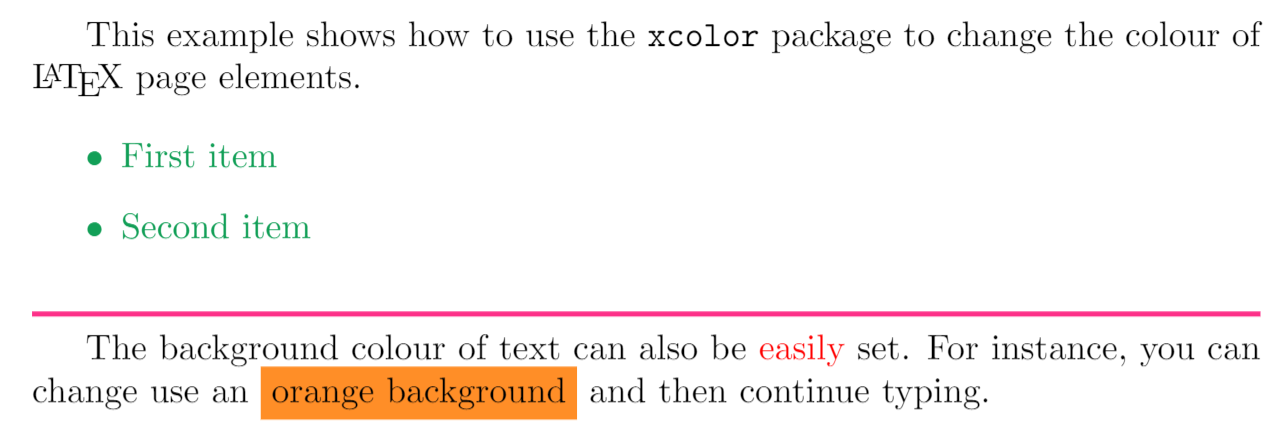
Two new commands are also used in the example:
- \textcolor : Changes the colour of inline text. This command takes two parameters, the colour to use and the text whose colour is changed. In the example the word easily is printed in red
- \colorbox : Changes the background colour of the text passed in as the second argument. In the example above, the words orange background are typeset on a background colour of BurntOrange .
Loading and using named colours in the color package
You can also use the color package and load named colours via its usenames and dvipsnames package options:
The following code uses the color package to apply the same named colours used in the previous xcolor package example.
This example produces the same output as the previous xcolor version:
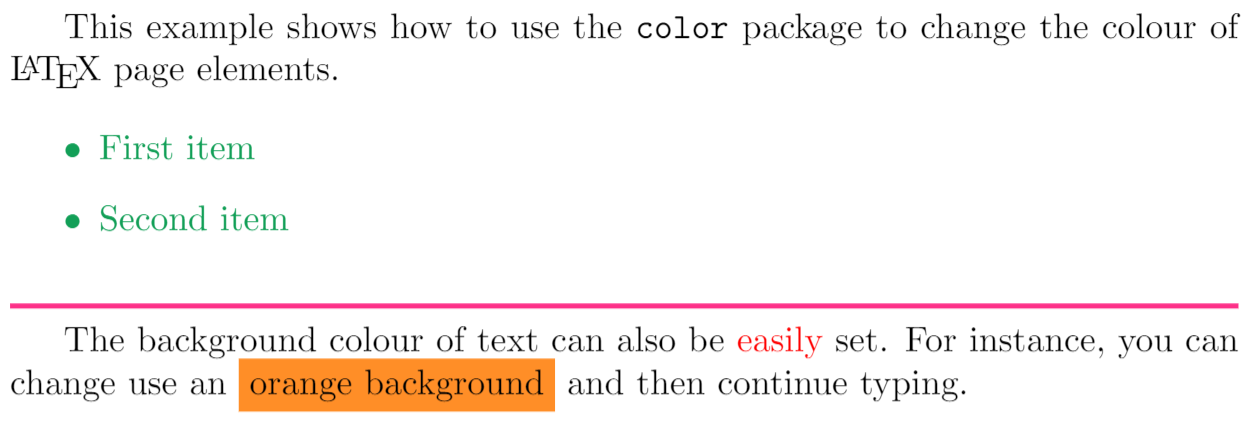
Drivers and colour
Use of colour when typesetting text or math was not part of the original design of TeX; instead, use/application of colour was delegated to external “drivers” which converted TeX’s original output file format (DVI) into PostScript or PDF. In order for colour to work, driver-specific instructions had to be “injected” into TeX’s output by using a built-in TeX command called \special whose job is simply to allow code/data to pass through the typesetting process and become embedded into the output file. When the chosen driver (software) processed the typeset output it would detect the embedded code/data and act upon it to achieve whatever the user intended—such as the use of colour.
Times have changed, and PDF is now by far the most common output format used by TeX engines, long supplanting the use of legacy DVI drivers and creation of PostScript. Users also have a greater choice of TeX engine to use for typesetting their LaTeX documents, most notably pdfTeX, XeTeX or LuaTeX/LuaHBTeX, so it is still important to take account of differences in those TeX engines—ensuring the correct mechanisms are used to insert colour data (PDF instructions) into their PDF files. To support and accommodate the legacy DVI output format and the wider environment of TeX engines and workflows in use, you can, if required, configure the color or xcolor packages to use a particular “driver” so that LaTeX will generate colour data using using the appropriate method.
Drivers for color and xcolor
The color package provides out-of-the-box support for the following driver options:
- dvipdfmx , dvips , dvisvgm , luatex , pdftex and xetex
There are other options as described in the color package documentation.
The xcolor package provides the following driver options:
- dvips , xdvi , dvipdf , dvipdfm , dvipdfmx , luatex , pdftex , dvipsone , dviwindo , emtex , dviwin , oztex , textures , pctexps , pctexwin , pctexhp , pctex32 , truetex , tcidvi , vtex and xetex .
Automatic colour driver detection
When typesetting your document LaTeX reads a configuration file called color.cfg which contains code that can determine if you are running pdfTeX, XeTeX or LuaTeX and automatically loads the appropriate driver ( .def file) for you, so you don’t need to specify the driver package option for those engines.
More advanced example using the dvisvgm driver to create an SVG file
The following example uses the color package with options that load named colours and the dvisvgm driver to output colour definitions/data using SVG code:
Specifically, the output file typeset by Overleaf is converted to SVG using a program called dvisvgm , which is part of TeX Live and available on our servers. To run dvisvgm , after the page is typeset, we use a latexmkrc file which is created when you open the following code in Overleaf:
Once Overleaf has finished compiling you can access the SVG graphic, called mygraphic.svg , by selecting Logs and outputs and choosing the Other logs and files dropdown list:
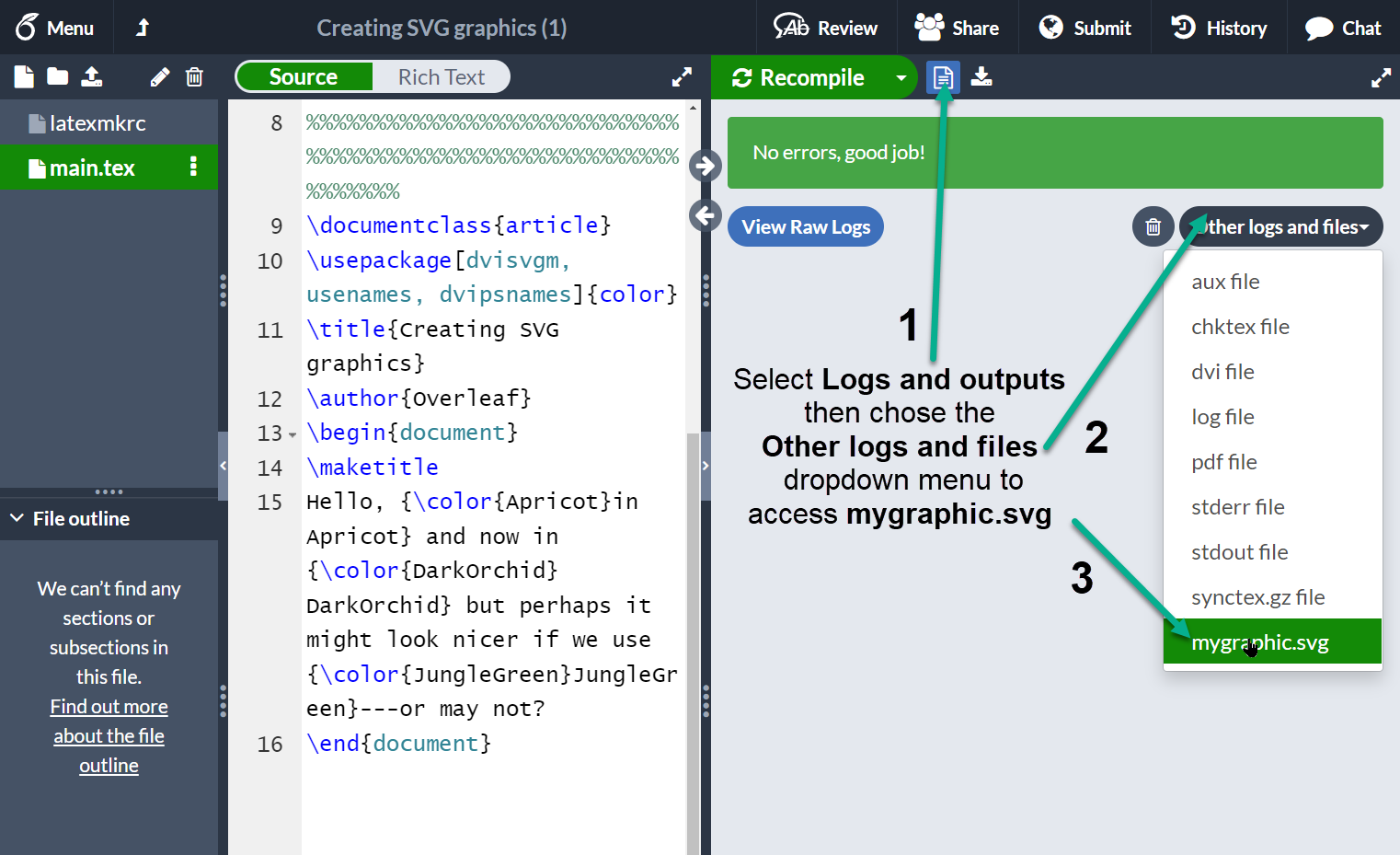
Creating your own colours
It is possible to define your own colours, the manner in which the colour is defined depends on the preferred colour model. The following example uses 4 colour models.
This example produces the following output:
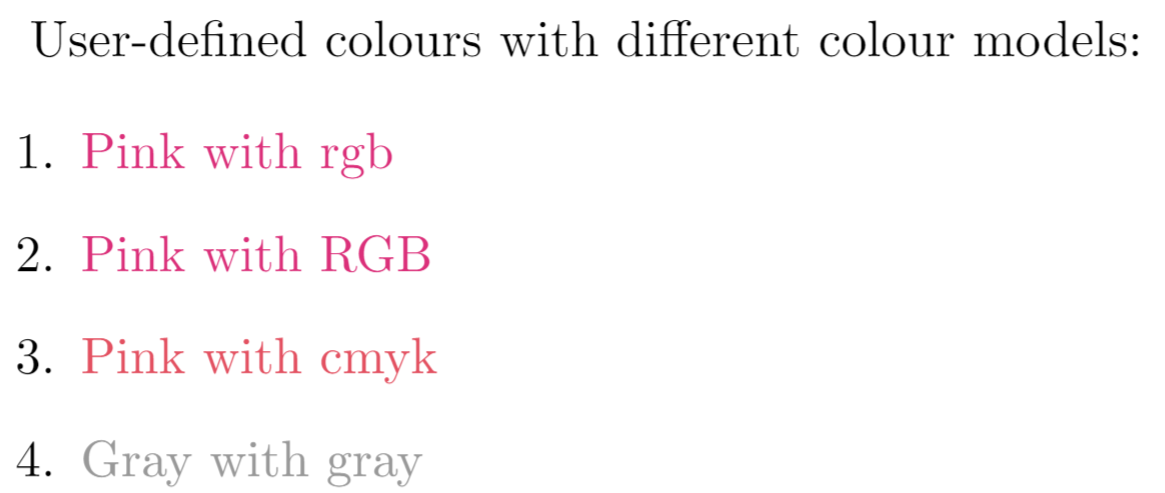
The command \definecolor takes three parameters: the name of the new colour, the model, and the colour definition. Roughly speaking, each number represent how much of each colour you add to the mix that makes up the final colour.
- rgb : Red, Green, Blue. Three comma-separated values between 0 and 1 define the components of the colour.
- RGB : The same as rgb , but the numbers are integers between 0 and 255.
- cmyk : Cyan, Magenta, Yellow and blacK. Comma-separated list of four numbers between 0 and 1 that determine the colour according to the subtractive CMYK model used by commercial printers.
- gray : Grey scale. A single number between 0 and 1.
In the example, mypink1 , mypink2 and mypink3 define the same colour but for different models. You can actually see that the one defined by cmyk is slightly different.
Colours defined by either model can later be used within your document not only to set the colour of the text, but for any other element that takes a colour as parameter, for instance tables (you must add the table option to xcolor ), graphic elements created with TikZ, plots, vertical rulers in multicolumn documents and code listings.
xcolor-only colour models
The xcolor package provides additional commands which provide support for more colour models and friendly colour mixing, as demonstrated in the following example:
This example produces the following output:

Three new colours are defined in this example, each one in a different manner.
- \colorlet
- : A new colour named LightRubineRed is created, this colour has 70% the intensity of the original RubineRed colour. You can think of it as a mixture of 70% RubineRed and 30% white. Defining colours like this lets you derive different tints of a main colour—common practice in corporate branding. In the example, you can see the original RubineRed and the new LightRubineRed used in two consecutive horizontal rules.
- \colorlet : A colour named Mycolor1 is created with 10% green and 90% orange.
- \definecolor : The colour Mycolor2 is created using the HTML model. Colours in this model must be created with 6 hexadecimal digits, the characters A, B,C, D, E and F must be in upper-case.
The colour models that only xcolor supports are:
- cmy : cyan, magenta, yellow
- hsb : hue, saturation, brightness
- HTML : RRGGBB
- Gray : Grayscale, a number between 1 and 15.
- wave : Wavelength, a number between 363 and 814. The number represents the wavelength of light, in nanometres (nm)
Setting the page background colour
The background colour of the entire page can be easily changed with \pagecolor . The following code demonstrates this, using the text of an earlier example::
This example produces the following output:
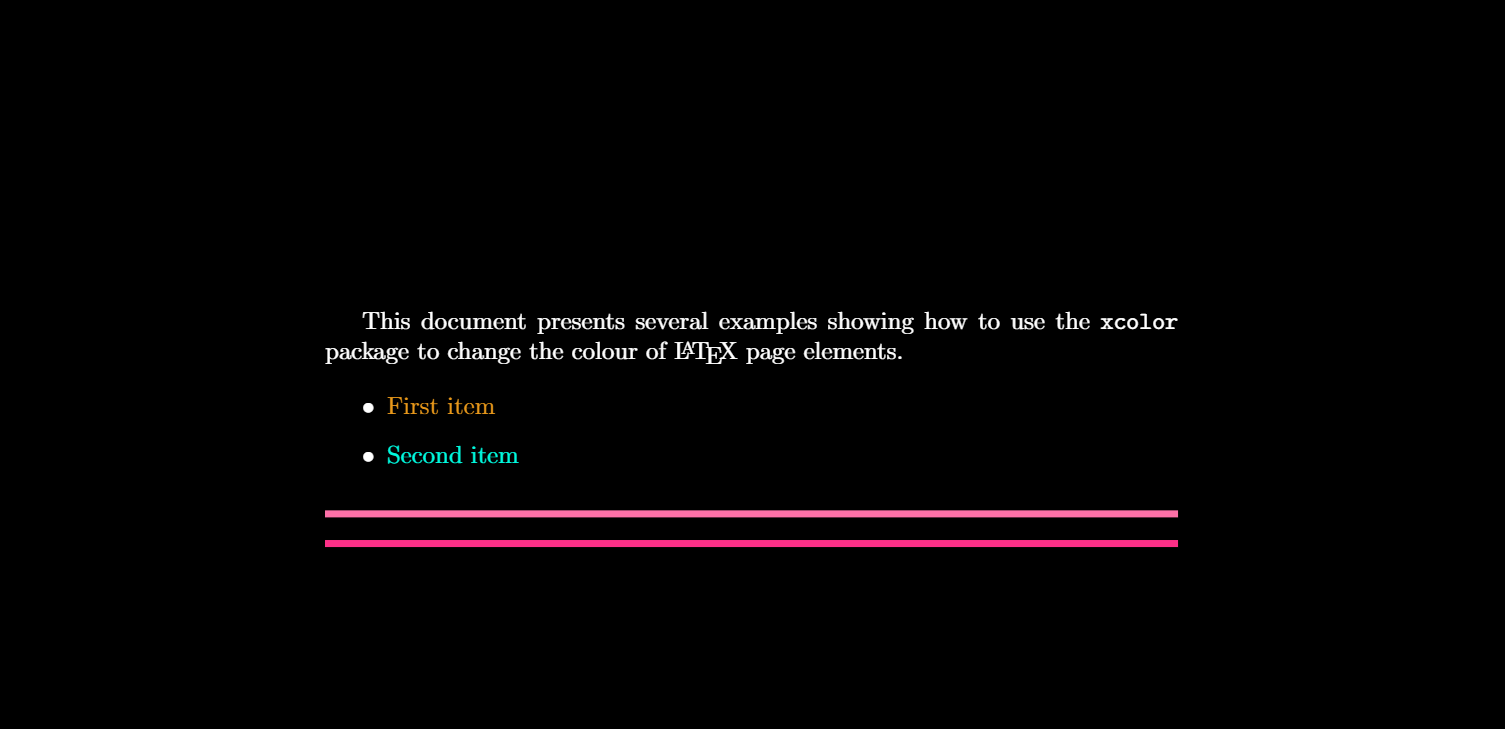
The command \pagecolor set the page colour to black . This is a switch command, meaning it will take effect in the entire document unless another switch command is used to revert it. \nopagecolor will change the background back to normal.
Техника росписи акриловыми красками по ткани

Какими красками рисуют на одежде? Какой материал годится для работы с ними? Акриловые краски идеально подходят для нанесения на ткань и кожу. Как закрепить рисунок? Как правильно рисовать и делать роспись на одежде, чтобы изображения дольше не выцветали и сохраняли первоначальный вид? Для этого нужно узнать о техниках и особенностях работы такими красками по ткани.

Акрил по ткани
Для рисования на тканевых полотнах и одежде акриловые краски – лучший выбор. Они созданы на основе полимеров, поэтому пигмент не проникает в структуру волокон, он покрывает их пленкой.

Материя становится плотной, но не менее эластичной.
Преимущества
Рисовать акриловыми красками многие мастера решают, основываясь на их достоинствах, к которым можно отнести:
- богатый ассортимент, доступность;
- безопасность в использовании;

- возможность применять воду как разбавитель;
- водостойкость покрытия рисунков на ткани (можно замачивать и стирать);
- устойчивость к машинной стирке.
Кроме того, акриловая краска подходит для создания разноцветных узоров, поскольку пигменты легко смешиваются, за счет чего можно создавать новые оттенки.

Ткань для работы
Можно ли рисовать и акрилом на разных тканях? Если говорить о выборе материи для начинающих, то допустимо использовать для работы с обычным акрилом различные текстуры.

Можно рисовать на любых материалах: плотном текстиле, дениме, тонком шелке, хлопке или льняной основе.
Но следует помнить о том, что структура окрашенных мест будут с более плотной текстурой, чем остальное полотно.
Подготовительные работы
Роспись по ткани акриловыми красками требует определенной подготовки. Перед тем, как рисовать, нужно выполнить следующие действия с материалом-основой:
- погрузить в холодную воду на один час, затем прополоскать под краном;
- просушить и прогладить теплым утюгом.

Если рисовать на ткани с тонкой текстурой (батисте или шелке), то желательно растянуть ее на деревянной рамке, пока не просохнет.

Если декорировать предмет гардероба и рисовать на одежде, то рекомендуется отделить один слой от другого картонкой либо плотной бумагой.
Виды росписи
Есть следующие техники росписи акрилом по ткани:

- свободная роспись (с использованием солевого раствора и без него);

- шибори или складной батик;


Тонкости техники росписи
Рисовать акрилом на разных материалах необходимо счетом следующих тонкостей:
- Несмотря на то, что можно разводить содержимое тюбиков водой, мастера чаще пользуются растворителями, поскольку это лучше влияет на адгезионные свойства акрила.
- Для защиты обрабатываемого участка материи под него подкладывают полиэтилен либо клеенку.
- Чтобы рисунок на ткани получился более четким, а акрил наносился легче, предпочтительно использовать кисточки с синтетическим ворсом. При этом каждый следующий слой нужно наносить, когда предыдущий полностью высохнет.

- Как закрепить изображение? Фиксировать краситель художники советуют утюгом не ранее чем через сутки после нанесения.
- Сначала кладут светлые оттенки, а каждый следующий слой должен быть более темным, чем предыдущий.
Методы нанесения
Далее перечислены несколько способов рисования (методы зависят от применяемого инструмента):

- шаблонная либо трафаретная печать (применяются специальные валики, поролоновые спонжи);

- создание рельефного контура в сочетании с нанесением кисточками.

Таким образом, можно акрилом рисовать по ткани и создавать красивые работы.
Если выполнять все по несложным правилам, удастся получить стойкое покрытие, несмываемое после стирок.

